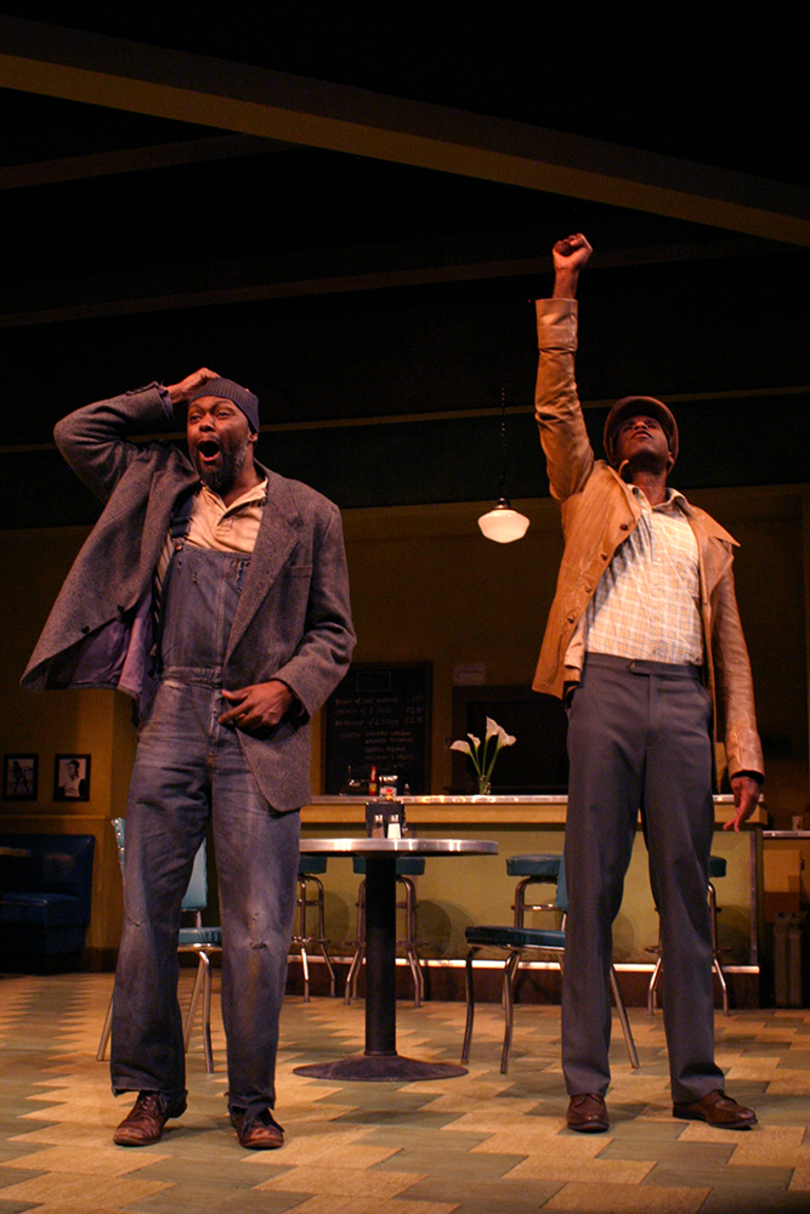‘Two Trains Running’ educates, entertains audience members with profound dialogue

(From left) Godfrey Simmons Jr. and Robert Manning Jr. perform in August Wilson's "Two Trains Running" at Syracuse Stage. Charlotte Horton | staff photographer
With the first African-American president and a growing progressive culture, people today don’t always think to look back at the civil rights movement and the difficulties African-Americans have faced.
But Syracuse Stage’s production of August Wilson’s “Two Trains Running” takes audiences back to the 1960s, a time before much of today’s equality existed. The play mixes somber subject matter with hilarious comedy and likeable characters, bringing back tough messages of the past for reflection. Running Jan. 30-Feb. 17, this production marks the 300th one at the Syracuse Stage since its founding in 1974.
Set in the late 1960s, when urban communities being torn down for renewal led to growing segregation in new neighborhoods, “Two Trains Running” takes place in a local diner scheduled to be bought and destroyed. The owner has lost many customers due to reconstruction, and is struggling to keep control of his business. He witnesses the struggles of his diner’s guests, who are searching for ways to get by in a racist society. All the while, the Black Power movement is growing around them.
The most striking aspect of “Two Trains Running” is how it simultaneously blends deep, political ideas about civil rights with lighthearted comedy.
The play focuses on themes of income inequality, prison, the ideas of Malcolm X, death and even self-mutilation. Yet the audience was still bursting into laughter throughout the play, with many sharp punch lines earning applause.
This created a pleasant tension in the play, without viewers seeing the seriousness but still wanting more. It isn’t totally successful, however, since the comedy often undermines the importance of the play’s themes, softening some of its effect. While the play still has many deep-reaching moments, especially toward the end, it doesn’t hit as hard as it should overall.
The biggest part of this strange balance is how the play’s well-acted cast carries their characters through each conversation. Each character has a simple yet memorable personality, and despite being jaded, still brings charm and humanity to their relatable struggles. Even during unexpected moments, like a falling stage prop, the cast remained firmly in character.
One of the most memorable performances was by G. Valmont Thomas as Memphis, the diner’s stubborn-yet-hard-working owner. After a difficult past as a victim of racist business practices, Memphis’ biggest goal now is to get the price he’s setting for his diner.
While Thomas’ character is somewhat loud, he makes up for it with his enthusiasm and defiant desire to control his own life, a relatable desire still present in many people trying to get by in today’s world.
The other standout character was Risa, played by Erika LaVonn, the diner’s strong and silent waitress. As an African-American woman and waitress, Risa struggled with subjugation all her life and even cut her legs to appear less attractive to men. However, her quiet and resistant personality captures a subtle, growing feeling of empowerment, arguably making her the play’s most significant character.
Sterling, a young man recently released from prison with a passion for the Black Power movement (and Risa), is played strongly by Robert Manning Jr., another notable role. His character appears naïve and foolish at times, such as randomly selling a tank of gas he found. But in the end, he’s shown to have a great heart within his recklessness.
Directed by Producing Artistic Director Timothy Bond,the playfully serious script and sharp acting are very strong points of “Two Trains Running,” but most other elements of the performance are good, but not great.
The stage direction was simple and rarely creative, as the story was driven almost completely by dialogue. There were only fleeting moments where lighting and sound highlighted the play’s emotion. Even though the play offers incredible food for thought, people looking for plays to overwhelm them with flashiness should look elsewhere.
Audiences won’t see any settings other than the diner, though the one location was created with incredible attention to the details of a 1960s restaurant. From the table accessories to the small glimpses of the world outside the diner, the stage design is impeccable and engrossing.
“Two Trains Running” may, at first, seem uncomfortable due to the focus on racism and struggles African-Americans faced in an increasingly segregated nation. However, it still brings enjoyment with sharp political humor and a cast that refuses to be anything but charming.
While it isn’t quite as good as it should be, it still takes a sensitive part of history and turns it into entertainment all theatergoers can enjoy, and contains important messages about where we are as a nation and where we were before.




